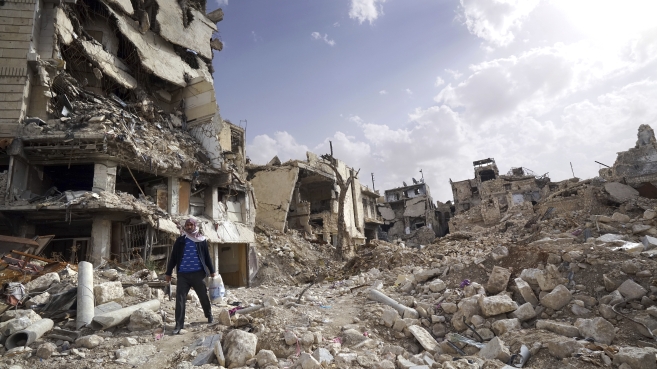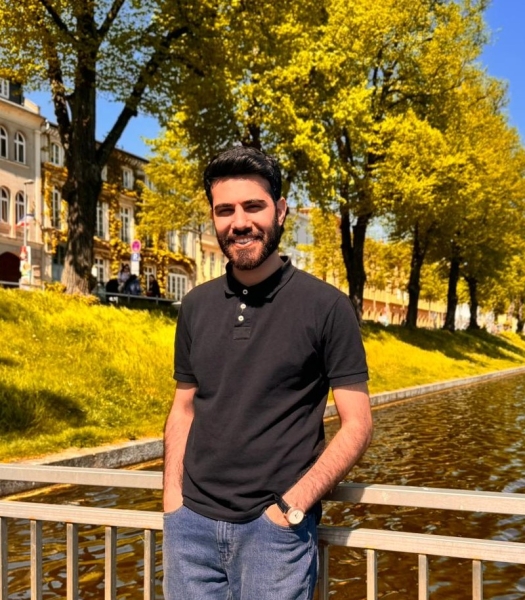
A returnee makes his way through piles of bricks in a heavily damaged part of Aleppo’s Old City, 5 November 2017. © UNHCR, Susan Schulman
Kaya Nadesan | International Network on Explosive Weapons (INEW)
On December 8, 2024, the Assad regime in Syria collapsed following 12 years of armed conflict between Syrian armed forces and Syrian opposition forces. Throughout the war, the Syrian government and other parties to conflict made extensive use of explosive weapons in urban areas. Aleppo, Raqqa and Homs were among some of the cities devastated by repeated shelling, strikes and bombardments, resulting in tens of thousands of civilian casualties and the destruction of vital infrastructure.
Muhannad Alnajjar was 14 years old when explosive violence began in Syria in 2012. He recalls the first time he saw an airstrike devastate a nearby apartment in his hometown of Homs City. He heard “one big sound” followed by the screams of neighbours, comparable to the soundscape of video games. In the weeks that followed, countless people from his neighbourhood lost their lives from shelling and the city he grew up in became entirely unrecognisable.
“The first moment felt like it was a game, I didn’t believe it was real. Me and my family under bombing? I couldn’t believe it.”
After those first strikes, his family left their apartment to seek refuge in the basement under their building where they lived for two months. In the fleeting moments between attacks, he and his father would leave to buy bread and any supplies they needed. He described his sense of time distorting watching his father as they ran across a street monitored by a sniper, “I would run first, then wait for my father to follow. Those few seconds, waiting and imagining that the sniper might shoot him, were among the worst moments I’ve ever experienced.” Ten seconds felt to him like an hour.
When war comes to cities, it twists children’s lives significantly and erodes their childhood, according to the ICRC. Muhannad remembers only three or four occasions where he and his younger siblings had bags of chips or candy. He said “we would never save them, not because we didn’t have the patience to save them, but because we didn’t know if we would be alive to eat them tomorrow.” He sat and ate them quickly while shelling outside ensued. Bombardment in urban areas robs children of normality – of playing with friends outside, of exploring their community, of going to school and receiving an education to serve them in their future.
Before shelling devastated his neighbourhood, Muhannad enjoyed school – the 15-minute walk there, playing football between classes and seeing his friends. But when the conflict escalated, his teachers waited outside the school gates to warn students: “Don’t come here again,” fearing the threats of bombardment. In the three years that followed, he moved schools six or seven times. The sound of bombing became increasingly present in his classrooms, often interrupting teachers during lessons or drowning out in-class conversations. His attention would move from his teacher to the plane outside firing missiles onto nearby residential blocks.
When explosive weapons such as mortars, air-dropped bombs or missiles are used in populated areas, they often damage or even destroy critical civilian infrastructure such as school buildings, even if the school was not the intended target, or not directly hit. The use of explosive weapons can make communities unsafe, forcing them to close schools due to nearby shelling or missile firing, leaving children without access to education. This consistent disruption of education or diminished quality can affect the future prospects of children and result in weakened educational systems.
“Even if you have plans for tomorrow and goals for the future, in one moment you can lose everything.”
Life became a waiting game for Muhannad. He described the vibrations of the building as resembling an earthquake when mortar shells and rockets broke into the walls. Eventually, the structure of their building became too precarious to live in, and after two months of nearly daily bombardment, his family made the difficult decision to leave their neighbourhood, their home and their life in Homs City behind. They were internally displaced twice as a result of the devastation of bombardments – once to Babila in Damascus, and then back to another area of Homs City after shelling drove them out of Damascus. They took with them the clothes they were wearing, whatever they could fit into a bag and an album of family photos. Muhannad expressed the confusion and inconceivable reality that came with displacement saying, “you lose everything, you leave everything behind you and are a different person – a new person with fear. You have hope you’ll go back to your home one day and find all your things.”
The use of explosive weapons in populated areas is both a key trigger and driver of displacement that forces children and families from their homes. Direct proximity to bombing and shelling can be a primary factor that forces civilians to flee their homes in armed conflict, according to Article 36. Being present in an area that is being bombed or shelled is a traumatising experience and if one’s home has been badly damaged or destroyed as a result of bombing, staying might not be possible.
“The fear became constant, every day felt like a gamble between life and death.”
The sounds of bombardment were so consistent over a prolonged period of time that they became oddly familiar to Muhannad and constantly played in his mind. Prolonged exposure to explosive weapons often leads to long-term negative effects on children’s mental health and psychological well-being, with frontline workers often observing high levels of post-traumatic stress disorder, anxiety, and depression in children in war, as highlighted by Watchlist on Children and Armed Conflict.
He became aware of how significantly this affected him during his first year of university in Berlin in 2024. When he heard fireworks for the first time on Bonfire Night he was immediately transported back to the reality of life under bombardment. In an instant, all the sounds of war returned. What others heard as celebration, Muhannad heard as war – fireworks like bombs, and joyful screams like the cries of the dying. “In my mind those sounds mean fear and I can’t separate them.” He catches his mind often wandering to memories of the shelling and the fear it brought – “it will be with me until my death.”
In his late teens, Muhannad volunteered as a paramedic with the Syrian Arab Red Crescent, a particularly harrowing experience, as he recalled seeing “pieces of people…hands, or heads, or legs.” He later volunteered with the Danish Refugee Council providing risk education to children and adults on unexploded ordnance. More recently, he began campaigning for humanitarian disarmament issues and now shares his experience and perspective to advocate for the better protection of civilians.
Muhannad says, “I have seen first-hand what happens when explosive weapons are used in populated areas, they kill and injure civilians who have nothing to do with the conflict, and leave behind devastation that lasts for generations. Civilians pay the highest price, there is no justification for turning homes into battlefields – the protection of civilians must always come first.”
“It wasn’t just buildings that changed, the people changed, they had more fear, you could see it in their eyes, and it stayed with me.”
In the wake of the significant escalation of conflicts in the region beyond Syria and extensive use of explosive weapons with wide-area effects in populated areas, the need to prioritise the protection of civilians is essential. The Political Declaration is a framework for strengthening the protection of civilians in armed conflict, including by placing limits on their use and better understanding how to prevent the effects that stem from damage and destruction to infrastructure. Action from states to endorse and implement the Political Declaration is crucial now more than ever.
 Muhannad Alnajjar is an international student with a strong passion for humanitarian work. He holds two degrees and has extensive experience in humanitarian mine action and emergency response, working with organisations such as the Danish Refugee Council and the Syrian Arab Red Crescent. He is also actively involved in disarmament campaigning as a Mine Action Fellow, and with the ICBL-CMC and Mines Action Canada. Muhannad is pursuing a Master’s degree in Berlin where he currently resides.
Muhannad Alnajjar is an international student with a strong passion for humanitarian work. He holds two degrees and has extensive experience in humanitarian mine action and emergency response, working with organisations such as the Danish Refugee Council and the Syrian Arab Red Crescent. He is also actively involved in disarmament campaigning as a Mine Action Fellow, and with the ICBL-CMC and Mines Action Canada. Muhannad is pursuing a Master’s degree in Berlin where he currently resides.
